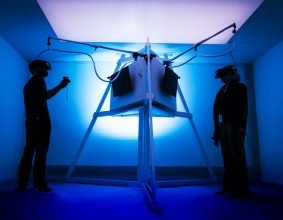
Streaming television is making an outsized impact on the media landscape. Since 2007, when Netflix started its streaming service, streaming media has altered the habits of the television viewer. Scores of new television programs and movies are available for the media consumer, including Carnival Row, Watchmen, and Living with Yourself. Netflix, Hulu, and Amazon Prime have all claimed their segments of the streaming market, and Disney+, HBO Max, and Peacock will soon be joining them.
Streaming’s giant impact on television has not stopped the search for the next innovation. As streaming begins to fall by the wayside in the coming decades, what will replace it? Michael Luisi, a seasoned studio executive and film producer based in California, explains how the television market will change in the years to come.
The Rise of Virtual Reality
The next big player in the world of television may be virtual reality or VR. Industry leaders are beginning to invest in the technology, with the potential of bringing television programs and movies to the VR-enabled consumer. In today’s world, virtual reality has become one of the leading visual technologies. Doctors use VR to plan out their surgeries in advance, leading to a safer and more efficient procedure for their patients. Architects and engineers use VR to design safe, energy-efficient buildings.
Thus far, VR has made an impact in video gaming through such platforms as the Oculus Rift, but it has not yet broken into the television and movie markets. There is a large measure of interest in the use of VR for entertainment. Many industry experts are interested in the potential for VR for scripted entertainment.
According to film producer Michael Luisi, VR first showed its entertainment potential in the mid-2000s. Second Life, in particular, was an absorbing video game where the user interacted with other players through the use of a virtual avatar. Luisi explains that Second Life pioneered the use of live in-game entertainment, showcasing a variety of musical artists including Suzanne Vega.
Oculus Rift, the VR gaming platform, has made some strides in the inclusion of entertainment programming on its service. In 2018, the platform introduced Oculus TV. This service gives viewers the opportunity to watch TV shows and movies, giving the effect of a 180-degree wraparound screen.
The Oculus Rift is prohibitively expensive for most casual consumers, but the technology is showing the way toward a virtual viewership experience in the future. Early adopters of the technology are already showing the market interest in VR programming.
Changes in the Television Landscape
As virtual reality platforms move away from the expensive headset model, they will be better able to reach a greater portion of the viewing population. Since the headset is expensive, other virtual reality companies are developing lower-cost sets and programs that do not use a headset at all.
Google Cardboard is a simple fix that allows most smartphone users to experience a VR environment. Using only their smartphones and a cardboard and plastic headset, consumers are able to interact with a wide variety of VR games and programs. Many consumers who would like to use virtual reality programs but cannot afford a more advanced headset may be surprised at the wealth of programming that is already available.
Virtual reality will cause a major change in how movies and TV shows are produced. Rather than filming with a handful of cameras, virtual reality will require an array. Sets will need to be created in 3D, and actors and directors will have to learn how to deal with the expanded field of view. When these programs are created, virtual reality viewers will enjoy being immersed in the world of their favorite TV show or movie. Combined with advances in special effects, VR television will represent a huge change in the market.
Another promising system in VR television, according to film producer Michael Luisi, is a combination of film and CGI. Backgrounds can then be created by an artificial intelligence system. VR technology will eventually be able to show films and movies in 3-D. This will bring a truly immersive quality to entertainment, changing how viewers interact with scripted, reality, and news programming.
Reducing Costs
As with many other technologies before it, VR has a high price for early adopters. Oculus Rift’s headsets cost about $400. Each viewer must have their own headset. Using smartphone headsets may be the simplest way to help VR television reach the market.
The New Frontier of Television
Just as the VCR and DVD player transformed television, VR is poised to follow suit. Many industry leaders believe in the possibilities of VR and will vouch for its market potential. VR shows and movies will immerse the viewer in a new world, giving them a transformative experience which they are unlikely to forget.
Michael Luisi encourages all industry professionals and media consumers to study the possible uses of VR in entertainment. He believes that the next wave of television will be precipitated by the rise of VR.
This is an article provided by our partners network. It does not reflect the views or opinions of our editorial team and management.
Contributed content

Founder Dinis Guarda
IntelligentHQ Your New Business Network.
IntelligentHQ is a Business network and an expert source for finance, capital markets and intelligence for thousands of global business professionals, startups, and companies.
We exist at the point of intersection between technology, social media, finance and innovation.
IntelligentHQ leverages innovation and scale of social digital technology, analytics, news, and distribution to create an unparalleled, full digital medium and social business networks spectrum.
IntelligentHQ is working hard, to become a trusted, and indispensable source of business news and analytics, within financial services and its associated supply chains and ecosystems




























